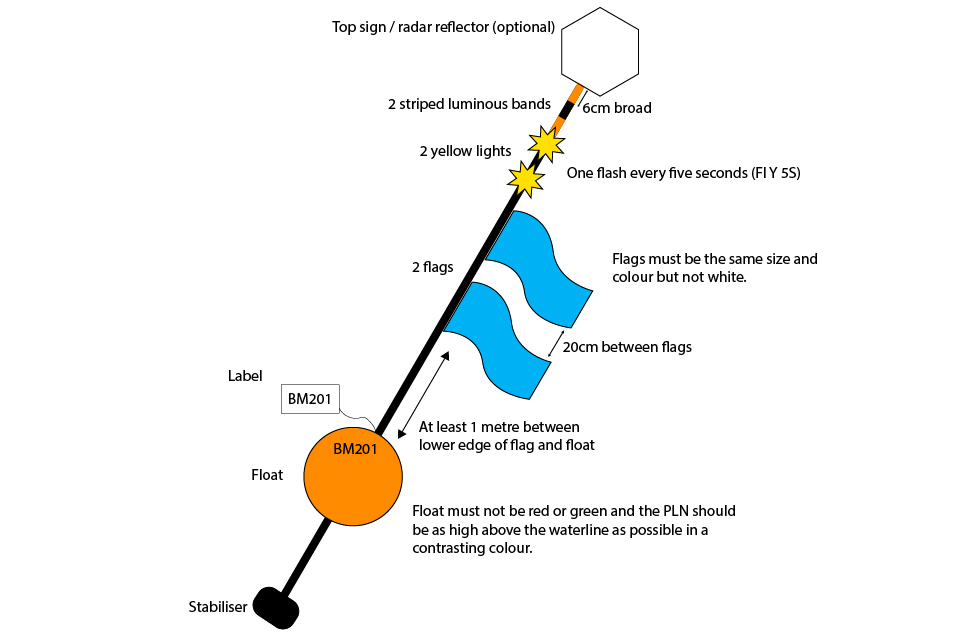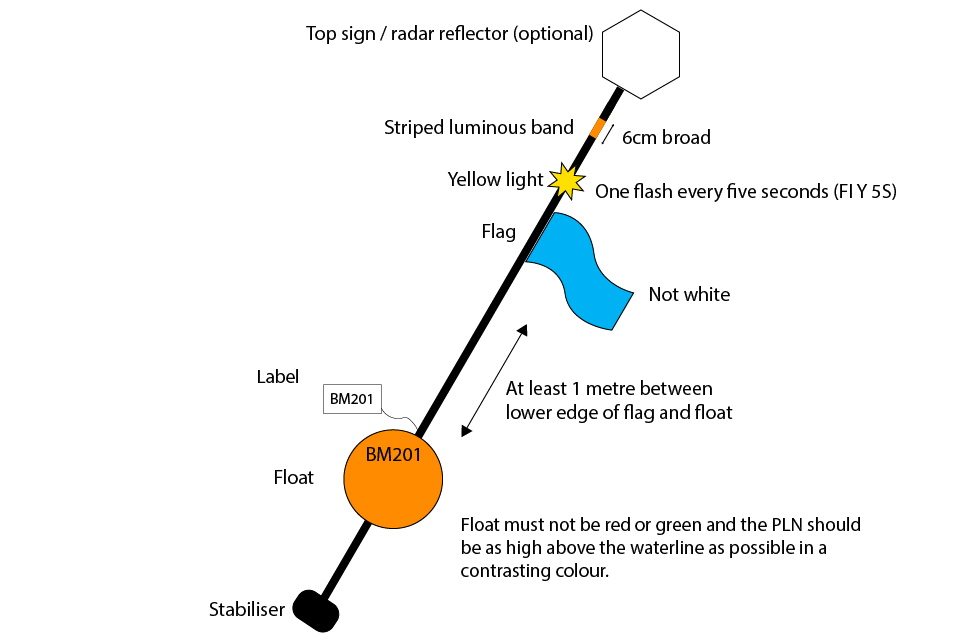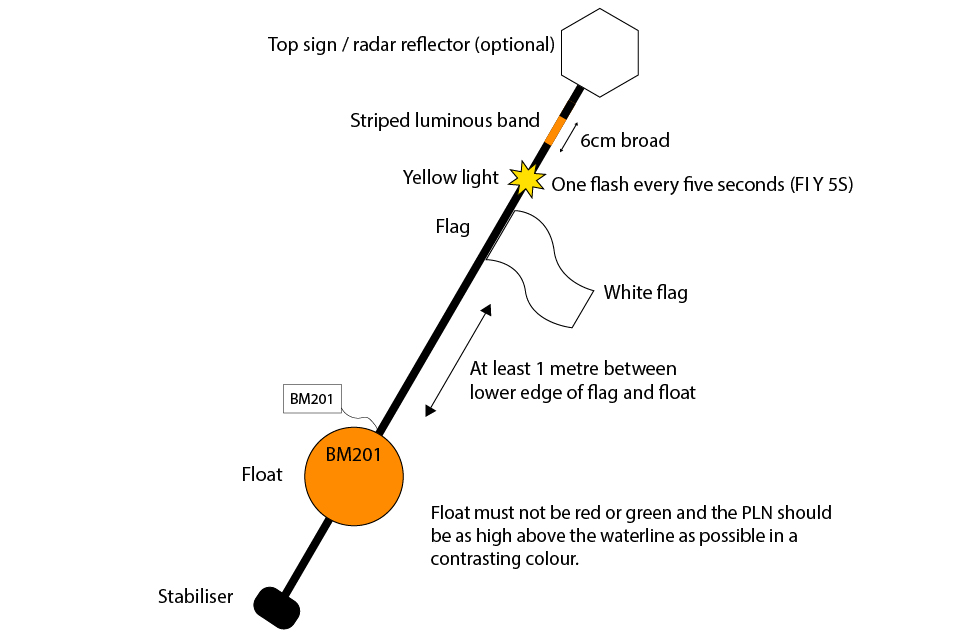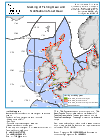Marking of fishing gear, retrieval and notification of lost gear
How different types of fishing gear must be marked, what you must do if you lose your fishing gear, how to report lost fishing gear.
Introduction
If you are the master of a Union fishing vessel and you are fishing using passive gear or beam trawls you must mark your fishing gear so that it is identifiable. The type of gear you use and whether you fish inside or outside territorial waters (the 12 nautical mile limit) will affect how you must mark your gear.
For all types of fishing gear, if you lose it you must attempt to retrieve it. If you are unable to do so you must notify the UK fisheries authorities.
Marking of fishing gear
You must mark passive gear and beam trawls with the port letters and numbers (PLN) of your vessel. This applies to the gear in use and gear you are carrying on board your vessel.
| Gear | Marking | 0 - 6nm | 6 - 12nm | 12 - 200nm |
|---|---|---|---|---|
| Beam Trawl | PLN | Yes | Yes | Yes |
| Passive gear | Label | Yes | Yes | Yes |
| Passive gear | Marker Buoy | Recommended | Recommended | Yes |
| Passive gear | IFCA* | Yes |
*Check with your local IFCA for any local marking requirements.
Marking of fishing gear chart
Beam trawls
A beam trawl is any towed trawl where the mouth of the trawl is held open by a beam or similar device. This does not include scallop dredges.
If you are fishing in European Union waters and use or carry on board a beam trawl you must clearly display your vessel’s PLN on every beam. Often this is welded onto the beam where it can easily be seen by an inspector.
Passive gear
Passive gear means any fishing gear where the catching operation does not require an active movement of the gear. Passive gear is also referred to as ‘static gear’. Passive gear includes:
- Set nets: Gillnets, entangling nets, trammel nets and trap nets
- Drift nets: Drifting gillnets and drifting trammel nets
- Lines and pots: Long lines, lines, pots and traps.
A guide to these fishing gears is available from Seafish
If you use or carry on board any of these types of gear you must mark it with labels and, additionally, if you operate outside territorial waters (the 12 nautical mile limit) you must use marker buoys.
Labels
In all EU waters you must mark any passive gear that you use or carry on board with a permanent label showing the PLN of your vessel. Each label must be:
- at least 75mm x 65mm in size
- made of durable material
- securely fixed to the gear and not removable
You must not alter, cover up, conceal, efface or otherwise make a label illegible.
You must attach the label to your gear as follows:
- nets: to the upper first row of meshes
- lines and longlines: at the point of contact with the mooring buoy
- pots and traps: on the ground rope
- marker buoys (where required): attached to the mast
If your gear extends further than one nautical mile, you must attach labels (as above) at regular intervals so that there is a label at least every nautical mile.
The UK fisheries authorities do not supply labels for fishing gear.
Marker buoys
If you use or carry on board passive gear in EU waters outside 12 nautical miles you must attach marker buoys to the gear in addition to labels. There are two types of buoy that must be used: end marker buoys and intermediary marker buoys.
Both types of buoy must display the PLN of your vessel:
- as high above the water as possible so as to be clearly visible; and
- in contrasting colours (e.g. Black on orange)
You must not alter or efface the marking or allow it to become illegible.
If you fish inside the 12 nautical mile limit it is recommended that you use buoys marked with your vessel’s PLN so that your gear is easily identifiable.
To attach the buoys to the passive gear you must use cords of submersible material or they must be weighted down so that they do not float to the surface. End marker buoys must be linked by cords to the furthest ends of the gear.
End marker buoys
You must use two end marker buoys so that each end of the gear can be determined at any time. You must rig end marker buoys with the specified number of lights, flags and reflectors depending on whether the buoy is in the western sector or eastern sector.
- Western sector: The half compass circle from south through west up to and including north.
- Eastern sector: The half compass circle from north through east up to and including south.
Intermediary marker buoys
If your gear extends further than five nautical miles intermediary marker buoys must be used at regular intervals of not more than five nautical miles so that no part of your gear is left unmarked.
Marker buoy requirements
| Buoy requirement | End Marker Buoy Western Sector | End Marker Buoy Eastern Sector | Intermediary Buoy |
|---|---|---|---|
| Mast height | At least 1 metre | At least 1 metre | At least 1 metre |
| Buoy colour | Coloured (not red or green) |
Coloured (not red or green) |
Coloured (not red or green) |
| Flags | 2 Not white 20cm apart |
1 Not white |
1 Must be white |
| Lights | 2 F1 Y 5S |
1 F1 Y 5S |
1 F1 Y 5S |
| Luminous bands | 2 | 1 | 1 |
| Label | 1 Attached to mast |
1 Attached to mast |
1 Attached to mast |
| Top sign/reflector | Optional | Optional | Optional |
| Attachment Location/frequency | Furthest end of gear | Furthest end of gear | For gear greater than 5nm: At least every 5nm. |
Table 2: Summary of marker buoy requirements
- buoys: These cannot be red or green to avoid confusion with navigational markers
- Mast height: This is measured from the top of the float to bottom edge of the lowest flag
- flags: flags used to mark the ends of the same gear must be the same size and colour
- lights: must be yellow and flash once every 5 seconds (F1 Y 5S) and be visible from a minimum distance of two nautical miles
- luminous bands: must be 6cm in width

Figure 1 Diagram of a western sector marker buoy

Figure 2 diagram of an eastern sector marker buoy

Figure 3 diagram of an intermediary marker buoy
Lost gear
If you lose your gear you must attempt to retrieve it. If you are unsuccessful then you must report your gear as lost.
Retrieval of lost fishing gear
If you lose all or part of your fishing gear you must attempt to retrieve it as soon as possible. You must carry equipment on board your vessel to retrieve lost gear unless you operate exclusively within the territorial waters (12 nautical mile limit), or you never spend more than 24 hours at sea from departing to returning to port.
Notification of lost fishing gear
If you cannot retrieve your lost gear you must inform the UK fisheries authorities within 24 hours of the following. the:
- PLN and name of your fishing vessel
- type of gear lost
- time when the gear was lost
- position where the gear was lost
- measures you took to retrieve the gear.
If you use an electronic logbook you can report lost gear using the lost gear declaration (GLS) when you submit your daily fishing activity report (FAR).
If you do not have an electronic logbook you must report lost gear to the UK Fisheries Monitoring Centre (UKFMC).
Telephone: +44(0)131 271 9700 Fax: +44(0)131 244 6471 Email: UKFMC@gov.scot
If your gear was lost in another member state’s waters the UK authorities will inform their competent authority.
If you do not report your gear as lost and it is subsequently retrieved by the UK or EU competent authorities, they may recover the costs from you.
If you break the law
As the master, owner or charterer of a Union fishing vessel you may be fined or prosecuted if you do not mark your gear correctly or retrieve or notify lost fishing gear.
The Marine Management Organisation (MMO) may investigate and take action in accordance with our compliance and enforcement strategy.
Penalties
A court may:
- give you an unlimited fine.
- order the confiscation of your fish or give you a fine to the value of the fish caught in committing the offence.
- order the confiscation of your fishing gear.
The MMO may offer you an administrative penalty up to a maximum of £10,000 as an alternative to court proceedings.
Read the financial administrative penalties for fisheries offences for more information.
Further information
Control Regulation Council Regulation (EC) No. 1224/2009 establishing a Community control system for ensuring compliance with the rules of the common fisheries policy.
Control Implementing Regulation Commission Implementing Regulation (EU) No. 404/2011 laying down detailed rules for the implementation of Council Regulation (EC) 1224/2009.
Acoustic Deterrent devices for static nets Certain vessels must use an acoustic deterrent device, known as a ‘pinger’, to reduce the level of dolphin and porpoise (cetacean) by-catch.
